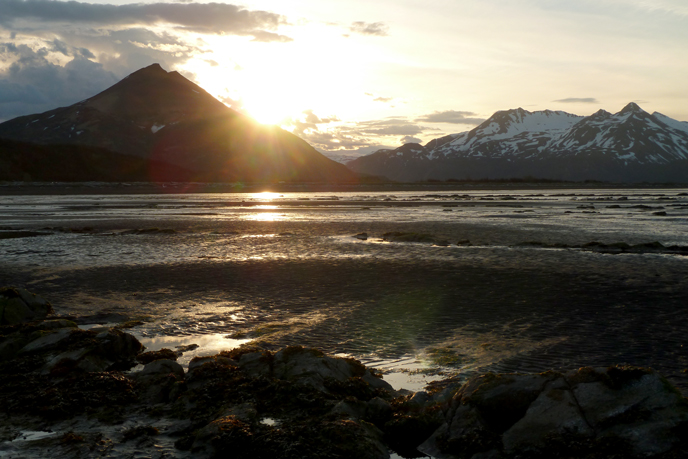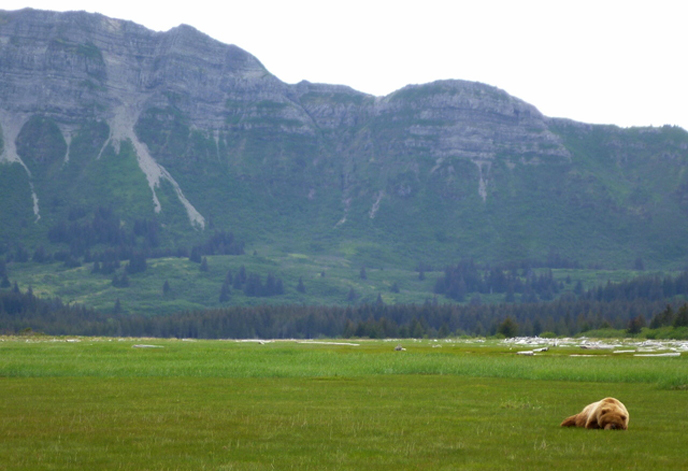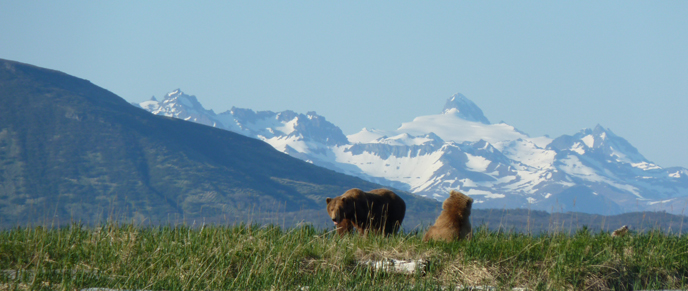
Sunset over Hallo Bay. (NPS/M. Fitz)
If and when the public think of Katmai National Park and Preserve, they are increasingly thinking of bears, particularly wild brown bears in relatively large concentrations. From the popular Alaska attractions of Homer and Kodiak many wildlife tours visit a place called Hallo Bay.
Located on the Pacific Coast, opposite the craggy beauty of Afognak Island, Hallo Bay stretches for some seven largely sandy miles at the base of the Aleutian volcanoes. A deep crescent within the larger Alaska Peninsula, the bay's arms terminate in imposing cliffs in the often mist shrouded expanse of the Shelikof Strait. Here, at the verdant embrace of salt water and narrow level land, lies a rich home for many of the best loved of Alaska's wild residents. With towering mountains covered in still expansive glaciers above this pristine habitat Hallo Bay frames a gently rolling table land of streams, bogs, dunes, and willow thicket, a slice of Alaska's salt marshes.
As I wandered this challenging ground I was struck by how feral the land seemed. No buildings, paths, restrooms, or other overt sign of human society greets the visitor. Access is strictly by bush plane, or perhaps boat, and the human visitor as well as the wild resident all are compelled to walk the landscape. The land itself is bisected, transected, and even further divided by the well worn and constantly evolving trails of all these walking animals. Wolves, foxes, and moose are not uncommon sights, but bears leave arguably the biggest impact on the land.

Signs of bears are easy to find in Hallo Bay. (NPS/L. Ehler)
At upwards of 1,000 lbs (~454 kg), Brown Bears are huge animals, apex predators, whose repetitive strides traveling the meadows grind meandering trails into the sandy soil. Massive and often remembered for their stubborn resilience and ferocity, Ursus arctos frequents the lush meadows and tidal flats of Hallo Bay primarily for grazing and courting. The intrepid visitor is led by their guides through the nutritious sedge (picture a thick, protein rich grass-like plant), observing these free animals as they graze the succulent shoots, and watch as they act out the complex social interactions that marks the life experience of a bear. Visitors are not allowed to approach closer than 50 yards (45 m) to the bears, but are rewarded with truly amazing memories of these animals. For the past ten days I was fortunate enough to live in this ecosystem as part of my duties as a park ranger.
A morning spent in the meadows can be rewarded with views of bears literally all around you, some seen with the aid of binoculars and others closer. This is a place that rewards personal forethought and planning, as your movements can take you over deceptive rises in the land that could mask bears heading in your direction. As the various guided groups of visitors navigate the landscape, the bears themselves are constantly moving as well, in reaction to each other or in unfortunate circumstances to the presence of humans.

Hallo Bay's sedge meadows are a popular wildlife watching destination the Pacific coast of Katmai. (NPS/L. Ehler)
Within the social world of a bear an individual's relative size and age dictates what spot they occupy on the landscape. Big bears displace smaller bears, often through subtle changes in body language or other cues. This results in the constant, slow paced movement of the animals, a primal sort of "dance." This bear dance can be accelerated during May and June with the excitement of mating season, as courting behavior bisects the slow grazing of the bears. This near constant movement could be likened in human culture to an all-you-can-eat buffet crossed with a dance club!
The potential bear couples, often referred to as courting pairs, will often continue eating while they flirt. The females are constantly walking with their suitor in tow across the meadows. Sometimes the female appears to be legitimately trying to evade their erstwhile companion, while more rarely the female may turn back in an attempt to entice a flagging suitor. After an indeterminate time the couple may consummate their relationship, before separating to continue feeding. Often as the couple are walking the landscape, another male bear may take notice and decide to interject himself as the more worthy (larger) suitor. Based on the hierarchy of size this switch in bears is often uncontested, but may come to blows. If a generalization can be made about bears, it is that the more dominant that an individual animal is, the less amount of work it needs to expend. The largest bears have access to preferred feeding areas, doing the least amount of work it can. On the ground this often appears as big bears strutting nonchalantly towards a perceived competitor. If the latter bear does not give way, this may escalate into more vigorous displays of yelling or even a fight, but this is rare. All these animals only have so many given months before it is time to hibernate once again, and drawn out brawling is a mortal danger. It is better to eat and grow fat on the land. So unless two bears close in size have a disagreement, the bear dance is deceptively smooth as the animals criss-cross the meadows.

June is the peak of the bear's mating season, so courting bears are a common sight in Hallo Bay. (NPS/L. Ehler)
While walking along the tall stacks of driftwood one can find the flotsam of the seas, trash labeled in the languages of Russia, Japan, Korea, the United States. My recent trip experienced a myriad of such partially buried “treasure,” including a lonely rubber duck, a decrepit motorcycle, and an adorable Japanese laundry detergent bottle complete with a pink bear mascot. Fishing nets and their associated floats are also to be found, a repository of everything that is lost overboard in the North Pacific. While the presence of this trash is a surprise for most visitors, not all impacts from the outside are as benign. As one walks the back meadows, in many places the muddy water has a distinct sheen, one most commonly associated with petroleum products.

Even in the wild beauty there are reminders of the outside world found, one organized and rationalized on a human scale. (NPS/L. Ehler)
Before Hallo collected the detritus of the sea, people visited this bay not only for a sense of the wild but for survival. In search of fresh game, clams, or other necessities of life the ancestors of the Alutiiq people have called the rocky coast their home. When a visitor today looks at a map the Alutiiq's long tenure is remembered in many of the local place names found. While many western colonizers intentionally tried to rename the landscapes they conquered, the Russians did the opposite. This decision was probably not an idealistic one, being motivated by the practical need to be able to communicate accurately with their native fur hunters, but the Russian legacy can be found in a treasure trove of native words. A Russian map from 1852 lists a bay "Ayu," which was recorded in the next decade as being pronounced like the word "hello." These place names were purchased along with this territory by the United States in 1867.
Hallo Bay today is a sanctuary within a sanctuary, a special corner of Katmai National Park and Preserve on the sea. This sanctuary is one of the special places where one can spend an afternoon contemplating the connections on the landscape, be it along a bear trail or across time. If you are interested in visiting Hallo Bay or would like more information, please visit https://www.nps.gov/katm/planyourvisit/bear-watching.htm.
